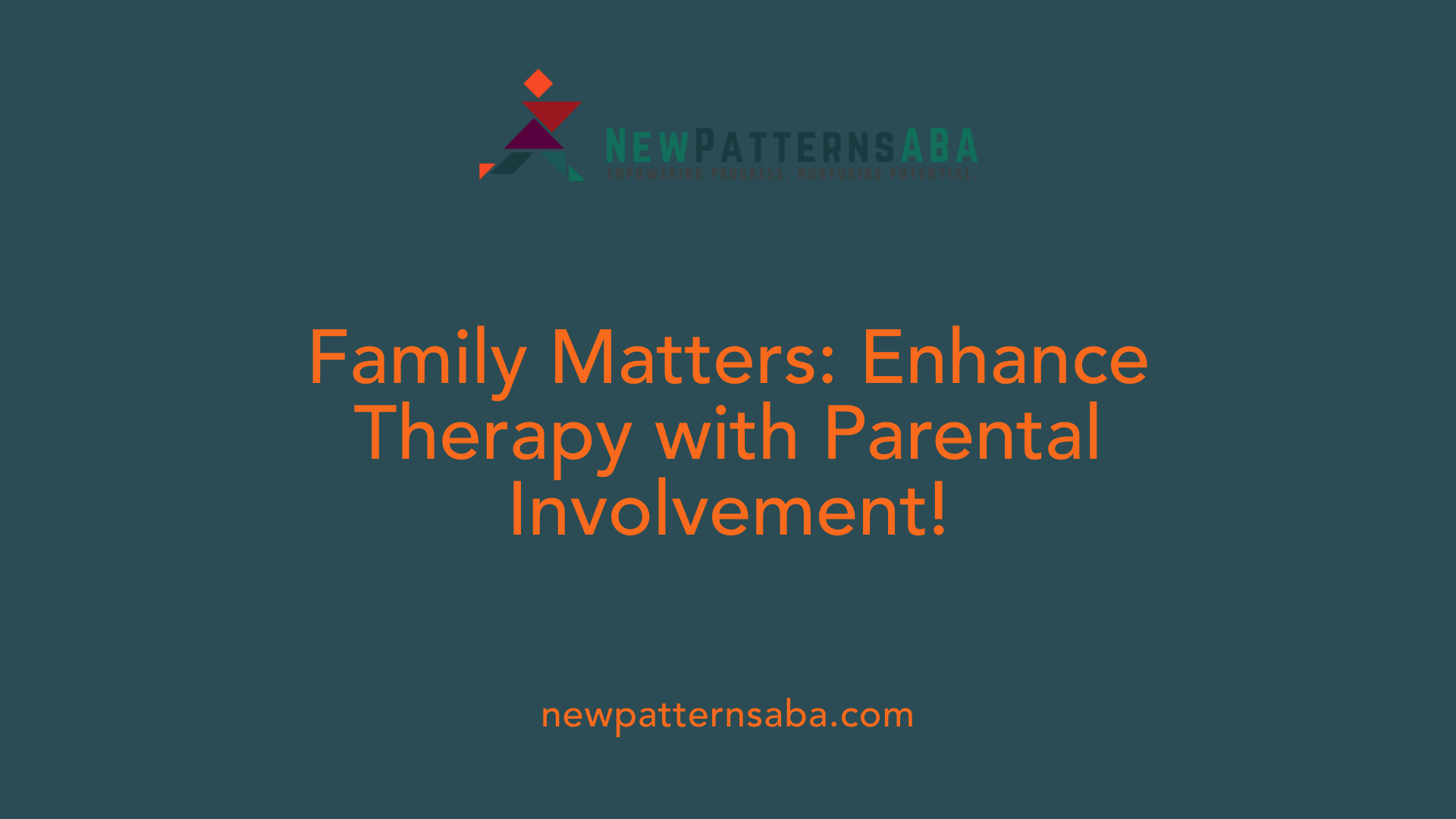Transforming Home Environments through ABA Strategies
Introduction: Bringing ABA Strategies into the Home
Applied Behavior Analysis (ABA) is a widely recognized therapeutic approach for children on the autism spectrum. Integrating ABA strategies into daily home routines can significantly enhance a child's learning, comfort, and development. By focusing on family involvement, consistency, and tailored approaches, home-based ABA therapy proves to be both effective and meaningful. This article delves into various strategies, benefits, and practical tips for creating a supportive and positive home routine using ABA techniques.
Understanding the Basics of ABA Therapy

What is home-based ABA therapy?
Home-based ABA therapy is a specialized form of therapy that occurs in a child's natural environment, which facilitates the integration of learning into their daily routines. It’s designed to cater to the unique needs of each child, making it engaging and effective. Family involvement plays a vital role in this therapy model, empowering parents and siblings to actively participate in the therapy process. This supportive dynamic enhances the child's progress and helps build strong skills relevant to their everyday life.
The therapy focuses on meaningful daily activities such as dressing and bedtime routines. This practical approach aims not only to tackle specific skill deficits but also to improve holistic functioning. Moreover, it includes a parenting curriculum to equip families with techniques for reinforcing positive behaviors. Home-based ABA services thus serve children with a variety of developmental challenges, but they are particularly beneficial for those on the autism spectrum.
Benefits of ABA in everyday environments
One of the standout advantages of home-based ABA therapy is its emphasis on real-life application. By conducting sessions in the child's home, the therapy enhances skill generalization, making it easier for children to apply learned behaviors in everyday situations. Families can incorporate flexible scheduling into their routines, accommodating times when the child is most receptive to learning.
Consistent routines established through ABA principles help children thrive. Visual supports such as picture schedules and timers support structured learning, reducing anxiety around transitions. Positive reinforcement serves as an effective method for encouraging desired behaviors, making learning a joyful experience rather than a chore.
Home-based ABA therapy not only addresses behavioral challenges but also fosters an environment conducive to overall growth and development, leading to increased independence and better management of daily tasks.
The Role of Family in ABA Therapy

Importance of Family Involvement
Family involvement is a cornerstone of effective home-based Applied Behavior Analysis (ABA) therapy. Parents and caregivers are actively engaged in the learning process, helping to implement techniques that reinforce their child’s development. This collaboration not only allows parents to better understand ABA principles but also empowers them to apply these strategies consistently outside of therapy sessions.
By incorporating daily activities into structured routines infused with ABA principles, families can enhance the effectiveness of therapy. For instance, using positive reinforcement during meal preparation or playtime helps solidify the skills learned during formal therapy. Moreover, consistent family engagement improves compliance, with reports of high success rates in implementing ABA techniques at home.
Enhancing Learning Through Collaboration
In-home therapy sessions are particularly beneficial as they take place in a natural learning environment. This encourages skill generalization and helps children apply learned behaviors in real-life situations. Visual supports, such as picture schedules and token boards, further aid in enhancing engagement, making routines clearer and more predictable for children with autism.
To effectively incorporate ABA therapy at home, consider the following strategies:
- Create Consistent Routines: Establish daily schedules that children can expect, helping to reduce anxiety and improve comfort in transitions.
- Use Positive Reinforcement: Provide praise or rewards when children complete tasks or follow routines, making learning a more enjoyable experience.
- Collaborate With Professionals: Stay connected with therapists for ongoing training and support, which builds parental confidence in applying ABA strategies.
Additionally, breaking tasks into smaller, manageable steps fosters independence while ensuring that children feel successful in their efforts. This parental support not only enhances learning but also promotes a strong partnership in addressing the unique needs of each child.
Implementing Positive Reinforcement at Home

What is the Concept of Positive Reinforcement?
Positive reinforcement is a cornerstone of Applied Behavior Analysis (ABA) therapy. It involves encouraging desirable behaviors by providing rewards when these behaviors occur. This approach shifts the focus away from punishment, creating a more supportive and engaging learning environment.
Examples of positive reinforcement in a home setting can range from verbal praise to tangible rewards. For instance, rewarding a child with extra playtime or favorite snacks after they complete a task successfully can motivate them to replicate that behavior in the future. By consistently applying these reinforcement techniques, parents can teach and encourage kids to develop essential skills in a constructive way.
How Can Parents Create a Supportive Learning Environment?
Creating a structured and supportive learning environment at home is crucial for successfully implementing ABA techniques. To achieve this, parents should:
- Establish Clear Routines: Develop a daily structure that outlines specific activities, incorporating ABA methods into everyday tasks. This provides predictability, which is particularly helpful for children on the autism spectrum.
- Use Visual Supports: Visual schedules and cue cards can improve understanding and engagement. Children can benefit from seeing their tasks illustrated, helping them anticipate and prepare for transitions throughout the day.
- Incorporate Frequent Reinforcement: Whenever a child follows routines or completes activities, immediate reinforcement—such as praise or a small reward—should follow. This helps maintain motivation and encourages developing habits.
What is an Example of Positive Reinforcement in ABA Therapy?
An example of positive reinforcement in ABA therapy is rewarding a child with a video game after they successfully complete a task, like getting dressed. This strategy encourages the behavior by providing a desirable outcome that motivates the child to repeat the behavior in the future. In center-based ABA therapy, the structured environment minimizes distractions, and trained professionals adjust strategies based on individual assessments.
By integrating social interaction and parental involvement, ABA therapy enhances both skill acquisition and behavior management.
Through consistent reinforcement and an organized environment, kids are more likely to absorb the valuable lessons ABA therapy provides, ultimately leading to improved day-to-day experiences.
Establishing a Structured and Predictable Routine

Creating effective routines
In home-based ABA therapy, establishing structured daily routines is essential for children with autism. These routines make it easier for children to navigate their lives, as they help break down complex tasks into manageable steps. Parents can start with core activities, such as mealtime, playtime, and bedtime, integrating them into a consistent schedule. This gradual introduction helps the child gain independence and reduces anxiety during transitions.
Incorporating tools such as visual schedules and timers can further enhance the effectiveness of these routines. These visual supports provide clear expectations, helping children understand what comes next throughout their day.
Importance of predictability
Predictability plays a vital role in the learning process for children on the autism spectrum. When routines are established, children experience less anxiety, as they know what to expect. A structured environment fosters comfort and enables them to apply learned skills across different settings like home, school, and community.
Furthermore, consistency in reinforcing desired behaviors is critical. Whether through positive feedback for completing tasks or gentle reminders during transitions, a predictable structure encourages habitual behavior, making the learning process enjoyable and effective. Through this approach, ABA therapy at home becomes a supportive environment where children can thrive and develop essential skills.
Tools and Techniques for Routine Management

Utilizing Visual Aids
Visual supports are invaluable in home-based ABA therapy. They help children understand and follow daily routines effectively. Tools like picture schedules and token boards provide clear visual cues that can guide children through their tasks. Picture schedules outline the sequence of activities, making it easier for children to anticipate what comes next, thus reducing anxiety during transitions.
Token boards offer immediate rewards for completed tasks, reinforcing positive behaviors. These visual aids not only boost engagement but also enhance comprehension, allowing for smoother learning experiences. Parents can create these tools at home, tailoring them to fit their child’s specific routine and needs.
Managing Transitions
Transitions can be particularly challenging for children with autism, which is where structured strategies come in. Countdown timers and visual cues can ease these shifts by preparing children for upcoming changes in their activities. For instance, announcing a five-minute warning before switching tasks helps set expectations and reduce resistance.
Incorporating these transitional strategies into daily routines promotes smoother changes and fosters a sense of security. This predictability is key in helping children navigate through their day, supporting overall development and engagement during ABA therapy sessions.
| Tool/Technique | Purpose | Benefits |
|---|---|---|
| Picture Schedules | Displays daily routines visually | Reduces anxiety, improves understanding |
| token Boards | Provides immediate rewards for tasks | Reinforces positive behavior |
| Countdown Timers | Prepares for transitions | Sets clear expectations, enhances comfort |
| Visual Cues | Aids in anticipating activity changes | Eases transitions, supports learning |
Flexible Scheduling Benefits in Home-Based ABA
Advantages of flexible scheduling
Home-based ABA therapy shines with its flexible scheduling, which caters to the unique needs of each child. This adaptability allows families to choose therapy times that suit their child's natural rhythms. By aligning therapy sessions with optimal learning times, children are more likely to engage effectively, making each session count.
Moreover, flexible scheduling supports the holistic well-being of the family. It integrates therapy into daily routines rather than interrupting them, making the experience less stressful for everyone involved. This seamless integration reinforces the skills learned during therapy by providing continuous opportunities for practice in real-life settings.
Integration into daily life
Incorporating ABA techniques into everyday activities is easier when families can choose when the therapy occurs. Parents can seamlessly weave therapeutic activities into morning routines or mealtime, enhancing the learning experience. For instance, simple tasks such as counting snacks or following a visual schedule can turn everyday events into learning opportunities.
This structure not only aids in generalizing skills across contexts — from home to school and community — but also helps children develop independence. With routines established during therapy, children can transition more smoothly through different environments, reinforcing the positive behaviors essential to their growth.
Overall, the flexibility of scheduling is integral to home-based ABA therapy, turning potential challenges into manageable parts of a child's daily life.
The Impact of Consistency in ABA Therapy
Role of consistency
Consistency is a cornerstone in Applied Behavior Analysis (ABA) therapy, especially for children on the autism spectrum. It establishes predictability in routines and expectations, which can significantly alleviate anxiety. When children know what to expect, they are more likely to engage positively with the tasks at hand. This structured approach allows them to focus on learning rather than worrying about what might happen next.
Since ABA therapy often involves breaking down complex behaviors into manageable components, maintaining a consistent approach helps reinforce learning. For instance, when positive behaviors are consistently acknowledged and rewarded, children are encouraged to repeat those actions. Inconsistent reinforcement can lead to confusion, making it crucial for caregivers and therapists to be unified in their responses.
Reducing anxiety through predictability
Children with autism benefit greatly from predictability. A structured environment reduces their chances of feeling overwhelmed. For example, using visual supports like picture schedules and timers can help children clearly see what comes next in their day. This visual reinforcement not only aids understanding but can also ease transitions, which is often a challenging aspect for these children.
Moreover, parents can enhance this predictability at home by integrating ABA strategies into daily routines. Involving the child in familiar tasks, paired with positive reinforcement when they engage successfully, promotes a sense of accomplishment and comfort. Therefore, the predictable structure provided by consistent routines can significantly boost a child's confidence and willingness to learn.
Strategies for Monitoring Progress and Setting Goals
Setting Clear Therapy Goals
Establishing clear and measurable goals at the outset of therapy is essential in home-based ABA therapy. These goals provide a roadmap for both therapists and families, allowing everyone to focus on the specific skills or behaviors that need improvement. Ideally, these goals should be tailored to the child’s unique needs, ensuring that therapy is both relevant and engaging.
Families are encouraged to collaborate with therapists to create these goals, as parental insight can significantly enhance the understanding of the child’s daily challenges and strengths. This connection fosters a shared commitment to the child’s development, making it easier to track progress over time.
Regular Progress Tracking
Consistent monitoring of progress is vital for assessing the effectiveness of therapy. ABA therapy employs data-driven strategies, allowing families and therapists to evaluate whether the set goals are being met and to determine if adjustments to the treatment plan are necessary. Progress can be tracked using various methods, such as behavior logs, visual supports like graphs, or even simple checklists, depending on what resonates best with the child and their family.
Regular feedback sessions should be scheduled, where caregivers can discuss observations and challenges with the therapist. This keeps the lines of communication open and ensures that any concerns can be addressed promptly.
By integrating structured progress monitoring into their routines, families can enhance the learning experience for their child, moving closer to achieving their therapy goals while fostering a supportive and positive environment.
Balancing ABA Therapy with Daily Responsibilities
How can families effectively implement ABA therapy?
Successfully incorporating home-based ABA therapy into daily routines relies on a structured approach. Families are encouraged to create designated time slots that seamlessly fit into their existing schedules. This structured therapy schedule not only allows parents to manage their daily responsibilities but also ensures that therapy becomes a routine part of life.
An essential aspect of effective implementation is the active involvement of parents and caregivers in the therapy process. They benefit from learning ABA techniques through training sessions and can apply these strategies at home, reinforcing the skills their child learns in therapy. This consistent application helps solidify new behaviors, creating a supportive learning environment.
What are some ways to overcome challenges with routine integration?
Integrating ABA therapy into daily routines can present challenges, particularly with transitions that children with autism may find difficult. To ease these transitions, strategies like countdowns or visual cues prove beneficial. These tools help make expectations clearer, reducing anxiety for children and increasing their comfort level during changes in activities.
Additionally, utilizing visual supports—such as picture schedules and token boards—can enhance engagement and understanding for children. With these visual aids, behaviors can be positively reinforced, transforming tasks into enjoyable experiences.
By establishing clear goals and maintaining predictability, families can help their child thrive within a structured environment, allowing both therapy and daily life to operate smoothly.
Enhancing Skill Generalization through Natural Environments
Home as a Learning Environment
Home-based ABA therapy provides a unique advantage by utilizing the child’s natural environment as a learning space. Conducting therapy at home allows children to engage with familiar settings, making it easier for them to apply learned behaviors in everyday situations. This approach promotes skill generalization, which is essential for children with autism, as it helps bridge the gap between therapy and real-life experiences.
Improving Skill Application in Real Life
When children practice skills in the context where they will use them, they are more likely to remember and apply those skills outside of therapy sessions. For example, routines established at home can help children learn to follow schedules, understand transitions, and manage tasks more effectively. Incorporating visual supports, such as picture schedules or timers, further aids children in understanding and engaging with their daily routines. This structured environment not only builds independence but also fosters comfort during transitions, thus enhancing overall skill application in different settings like school and community.
Additionally, consistent positive reinforcement encourages children to repeat desired behaviors. By making learning enjoyable and predictable, home-based ABA therapy creates a solid foundation for skill generalization and lifelong learning.
Modified Task Characteristics and Environment Adjustments
What are examples of proactive strategies in ABA?
Proactive strategies in Applied Behavior Analysis (ABA) are crucial for creating a supportive environment that enhances learning while minimizing challenging behaviors. Here are some effective examples:
Modifying Task Characteristics: Adjusting the complexity or length of tasks can significantly influence a child's engagement. For instance, breaking down tasks into smaller, manageable steps helps prevent frustration and increases the likelihood of success.
Reorganizing the Physical Setting: Arranging the learning environment to minimize distractions enables better focus. This can involve decluttering, ensuring that materials are easily accessible, or setting up designated areas for different activities.
Clarifying Routines and Expectations: Clearly defined routines reduce uncertainty and help children understand what is expected of them. Visual schedules, timers, and explicit instructions can provide valuable supports in establishing a predictable daily structure.
Changing Social Interactions: Encouraging positive, supportive interactions with peers and adults fosters a sense of community. This can include collaborative group activities that reinforce social skills alongside academic goals.
Providing More Choices: Giving children a choice in their activities enhances their engagement and motivation. Allowing them to select a preferred task or activity can lead to more positive outcomes.
Conducting functional assessments is pivotal. These assessments identify triggers for challenging behaviors and inform tailored interventions that suit individual needs. By implementing effective proactive strategies, families can create an enriching environment that supports children's development and learning.
Supporting Positive Behavior
Creating an atmosphere conducive to positive behavior involves consistent application of strategies that reinforce desired actions. Regular progress monitoring is essential to evaluate how well these strategies are working. Here are additional ways to support positive behavior in ABA:
Consistency in Reinforcement: Consistently acknowledging and rewarding positive behaviors encourages children to repeat those actions. Use of token boards or praise enhances their motivation.
Structured Routines: Daily routines that are predictable help children transition smoothly between tasks and reduce anxiety. Implementing visual supports for routines, such as picture schedules, makes it easier for children to understand what comes next.
Parental Involvement: Active participation by parents and caregivers is critical. They can reinforce skills practiced during therapy at home, fostering a supportive learning environment.
Incorporating environmental adjustments and proactive strategies into daily routines not only helps manage behaviors but also empowers children with autism to thrive in their everyday lives.
Integrating ABA into Core Daily Activities
Building Independence
Integrating Applied Behavior Analysis (ABA) into daily routines can significantly enhance a child’s learning experience. Parents are encouraged to begin with simple tasks, weaving a few core daily activities into a structured routine. This builds independence as children learn to navigate their responsibilities while fostering self-reliance.
Setting specific goals for daily activities provides a clear path for achieving developmental milestones. For instance, children can be guided to participate in tasks like dressing, brushing teeth, or tidying up their space. Each achieved task should be met with positive reinforcement. This affirming approach not only encourages the child but also solidifies the behavior into their daily life.
Comfort with Transitions
Transitions can often be challenging for children on the autism spectrum. To ease this, strategies such as visual cues, countdowns, and timers can be very effective. By employing these supportive measures, parents can prepare children for upcoming changes more smoothly.
A structured routine accompanied by visual schedules and token boards fosters predictability, significantly reducing anxiety around transitions. Children feel more secure and are better able to anticipate changes in their environment, which in turn, enhances their learning and emotional well-being. Encouraging these structured routines not only aids in daily learning but also creates a nurturing, supportive atmosphere where children can thrive.
The Critical Role of Parental Involvement and Training
Why is parental training important in ABA therapy?
Parental training in Applied Behavior Analysis (ABA) therapy is crucial for enhancing the effectiveness of treatment. It empowers parents and caregivers with techniques to support their child's development directly at home. Parental involvement ensures that skills learned during therapy are reinforced consistently, which is vital for promoting positive behavior changes.
How can parents effectively apply ABA techniques at home?
Parents can utilize various tools and strategies to implement ABA techniques effectively:
- Online Training Programs: These resources equip parents with a foundational understanding of ABA principles and methodologies.
- Structured Routines: By creating daily schedules that incorporate ABA activities, parents can help their children generalize skills across different environments, such as home and school.
- Visual Supports: Tools like picture schedules and token boards are essential in helping children understand routines and expectations, reducing anxiety.
What are the outcomes of effective parental involvement?
Research indicates that families who follow structured training programs often report high compliance rates in implementing ABA strategies, with some noting effectiveness ranging from 56% to 99%. This engagement allows children to thrive in supportive settings, ensuring their behavioral goals are met consistently. Moreover, positive reinforcement strategies help make learning enjoyable, fostering an environment where children are motivated to succeed.
Addressing Challenges with Consistent Reinforcement
Preventing confusion
In the realm of Applied Behavior Analysis (ABA) therapy, the importance of consistent reinforcement cannot be understated. Inconsistent application of reinforcement strategies can lead to confusion in children, particularly for those on the autism spectrum. Confusion may arise when a child receives different responses for the same behavior, leading them to question what is expected of them. This unpredictability can inadvertently increase anxiety, negatively affecting their ability to learn new skills or behaviors.
Consistency in reinforcement
To mitigate these challenges, caregivers must establish clear and consistent reinforcement guidelines. Reinforcement should be immediate and aligned with the desired behavior, allowing the child to make a strong connection between actions and rewards. By doing so, caregivers and therapists create a more predictable learning environment, enabling children to thrive. Regular practice of reinforcement techniques can help inculcate positive behaviors, making them more habitual.
Visual supports, such as token boards or charts, can enhance the consistency of reinforcement, providing tangible evidence of progress and encouraging participation in routines. As families aim for effective ABA therapy outcomes, ensuring continuity in reinforcement strategies is essential for fostering understanding and successful learning.
Visual Supports for Enhanced Engagement
Use of Visual Schedules
Visual schedules are powerful tools in home-based Applied Behavior Analysis (ABA) therapy. They provide a clear overview of daily routines and expectations, helping children with autism understand what comes next. By displaying pictures or icons representing each activity, these schedules reduce anxiety and promote predictability. As children know what to expect, they are less likely to feel overwhelmed, which creates a more conducive environment for learning.
Parents can start by creating a simple visual schedule that incorporates routine tasks such as meal times, therapy sessions, and play. This not only helps children feel more in control but also encourages cooperation during transitions between activities. A visual aid makes it easier for them to grasp daily tasks, ultimately aiding in skill generalization across different environments, such as home and school.
Token Boards
Token boards serve as another effective visual support in ABA therapy. These boards can be used as a reinforcement tool, where children earn tokens for completing tasks or following routines. Each token represents a small success or a behavior that needs encouragement, which motivates children to participate actively in their learning process.
The visual element of a token board helps children see their progress in real-time, making the reinforcement process clearer and more engaging. Once a certain number of tokens are collected, children can work towards a rewarded activity they choose. This not only reinforces good behavior but also creates a positive feedback loop, where children learn that their efforts lead to tangible rewards.
Incorporating both visual schedules and token boards in home-based ABA therapy significantly enhances engagement and understanding for children, making the learning process both enjoyable and effective.
Insights on ABA Therapy Feedback and Compliance
What does parent feedback reveal about ABA therapy?
Research indicates that parent feedback on home-based Applied Behavior Analysis (ABA) therapy is generally positive. Many parents report significant improvements in their child's behavior and development, noting that the personalized approach helps tailor sessions to their child's needs. They appreciate the emphasis on positive reinforcement, which fosters a supportive learning environment. Moreover, parents find that their involvement in the therapy process not only enhances their child’s skills but also builds their own confidence in implementing strategies at home.
What are the adoption rates for ABA therapy?
Adoption rates for home-based ABA therapy are impressively high, ranging between 56% and 99%. This indicates strong compliance with implemented strategies, although some families face challenges integrating therapy into their daily routines. The flexible scheduling of home-based therapy allows families to incorporate sessions into their existing activities, making it easier to maintain adherence. As a result, many families find success in establishing structured daily routines that facilitate the generalization of skills learned in therapy, further enhancing their child's learning experience.
Conclusion: Embracing ABA Strategies at Home
Establishing a positive and structured home routine using ABA therapy strategies can profoundly impact children on the autism spectrum. Through parental involvement, consistent reinforcement, and tailored therapy plans, families can create an environment conducive to learning and personal growth. As families and therapists collaborate, children are empowered to thrive, self-regulate, and develop essential life skills. By embracing the flexibility and personalized approaches ABA therapy allows, families can seamlessly integrate these practices into their everyday life, ensuring a nurturing and supportive environment for their child's development.
References
- Effective Scheduling Strategies for Home-Based ABA Therapy
- How ABA Therapy Builds Consistency for Lasting Success
- Implementing In-Home ABA Therapy
- Incorporating ABA Therapy Activities into Daily Routines at Home
- Home-Based ABA Therapy - Autism Learning Partners
- Autism Learning Partners | Making Progress Possible
- Services - Autism Learning Partners
- Top Benefits of Center-Based ABA Therapy: Guide for Parents
- ABA Therapy at Home: All You Need to Know
- Can parents do ABA at home?






